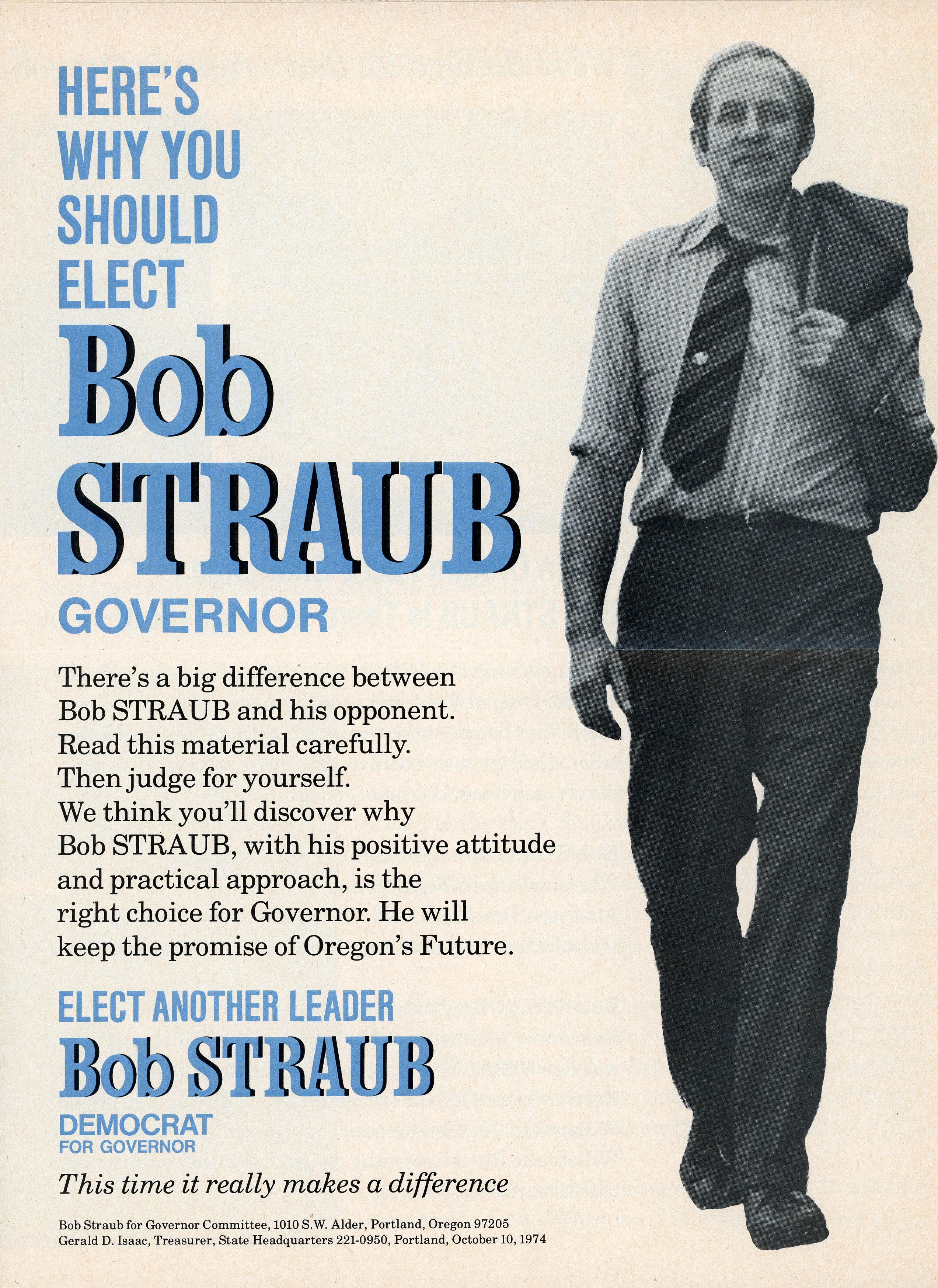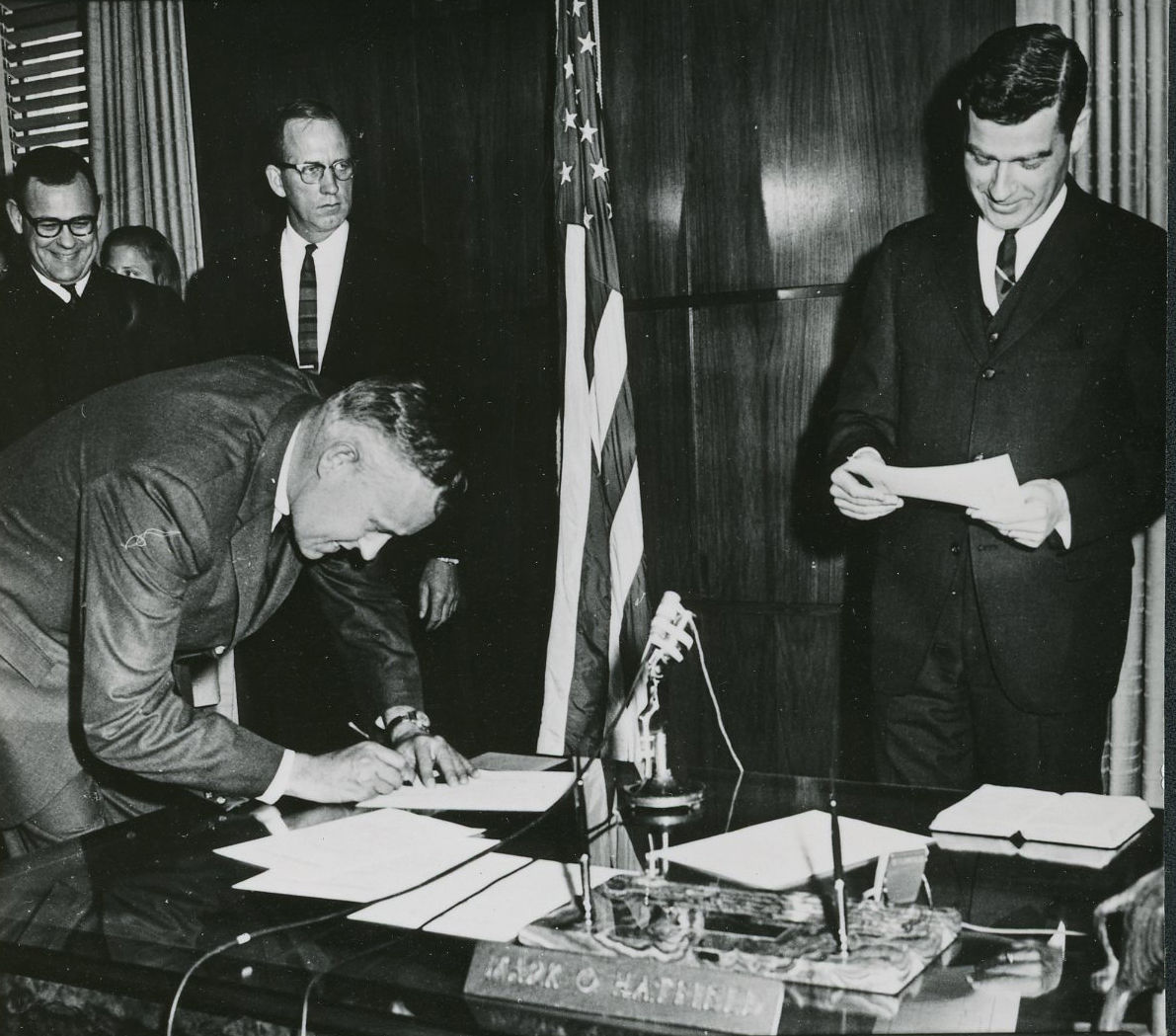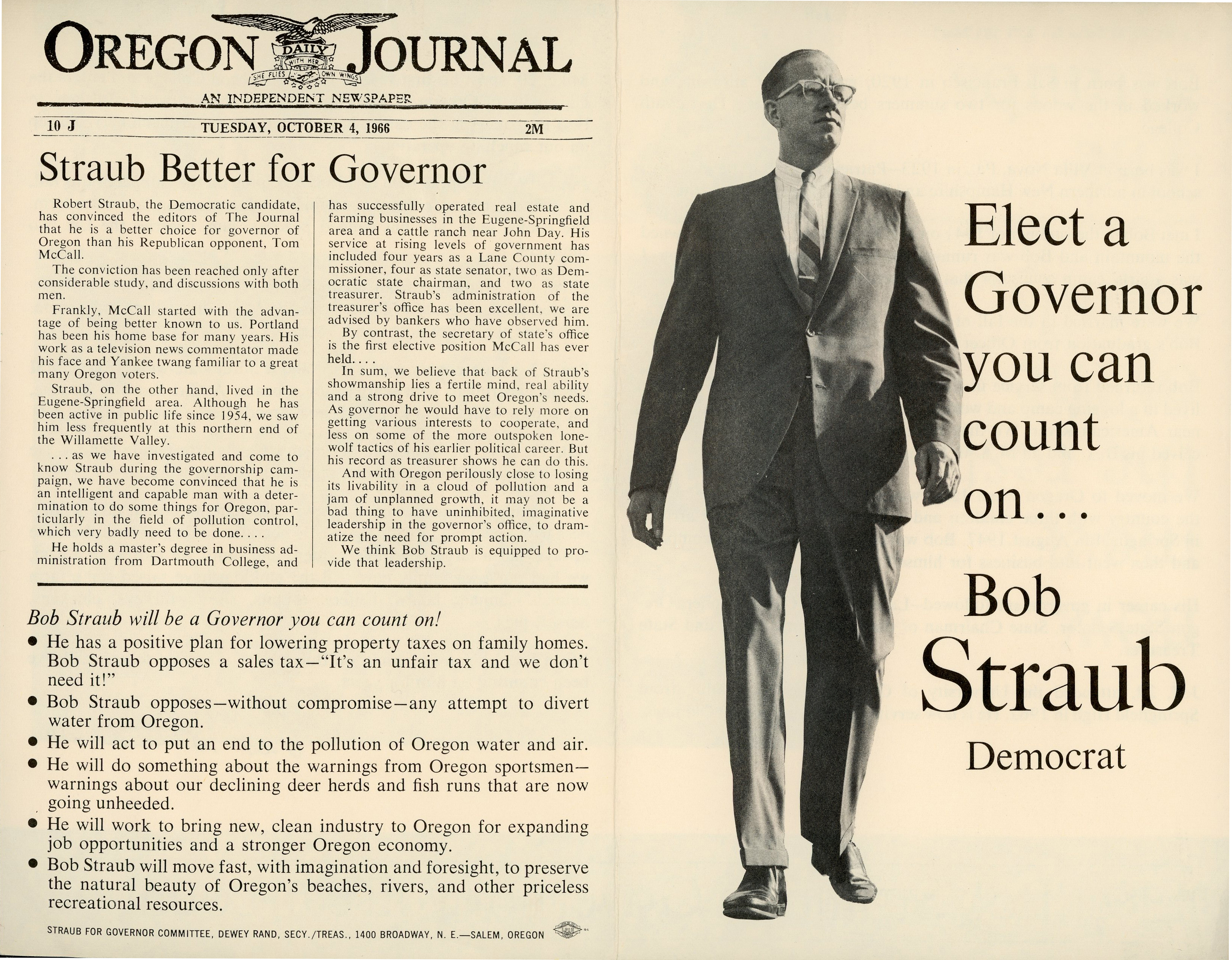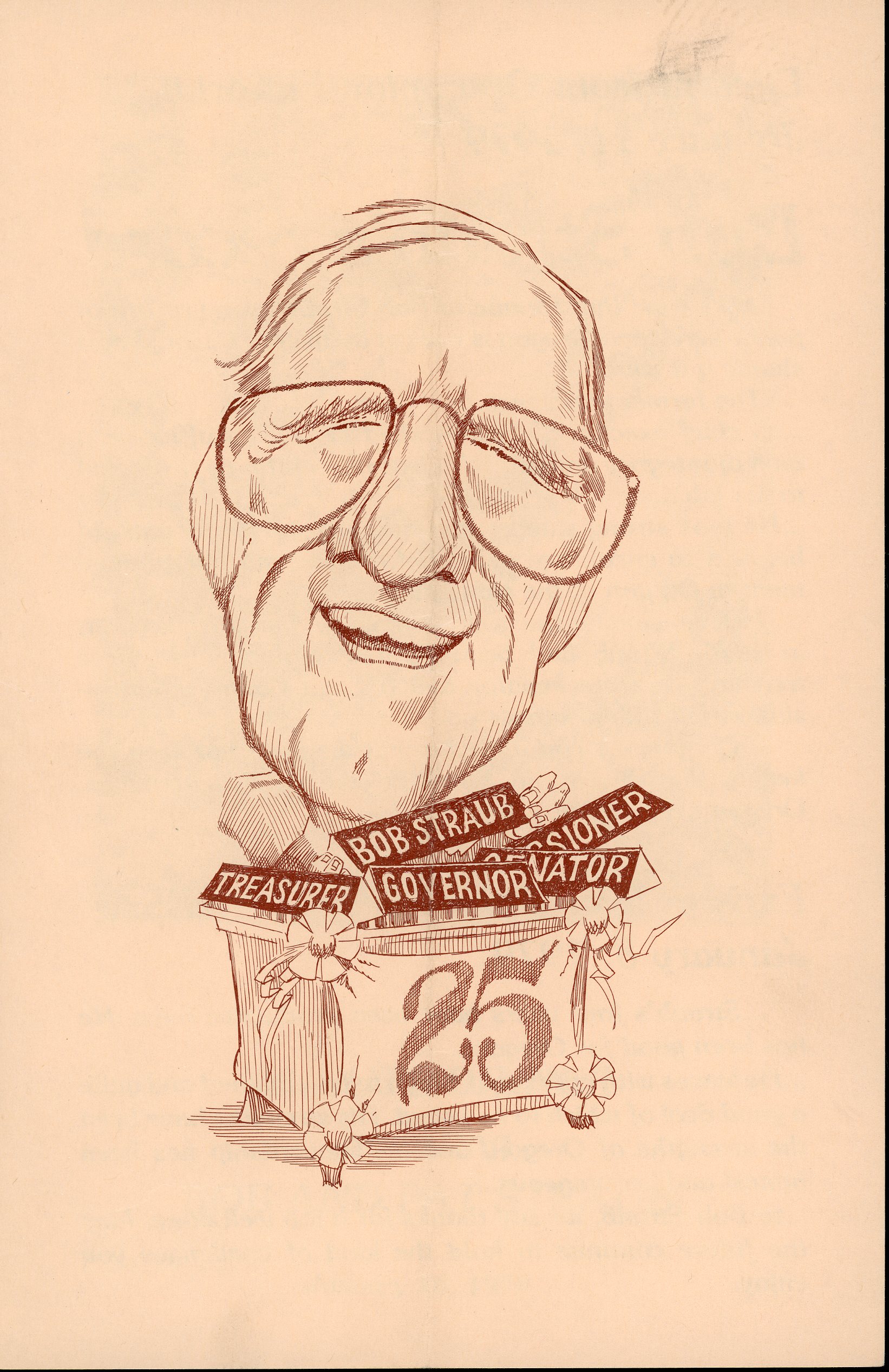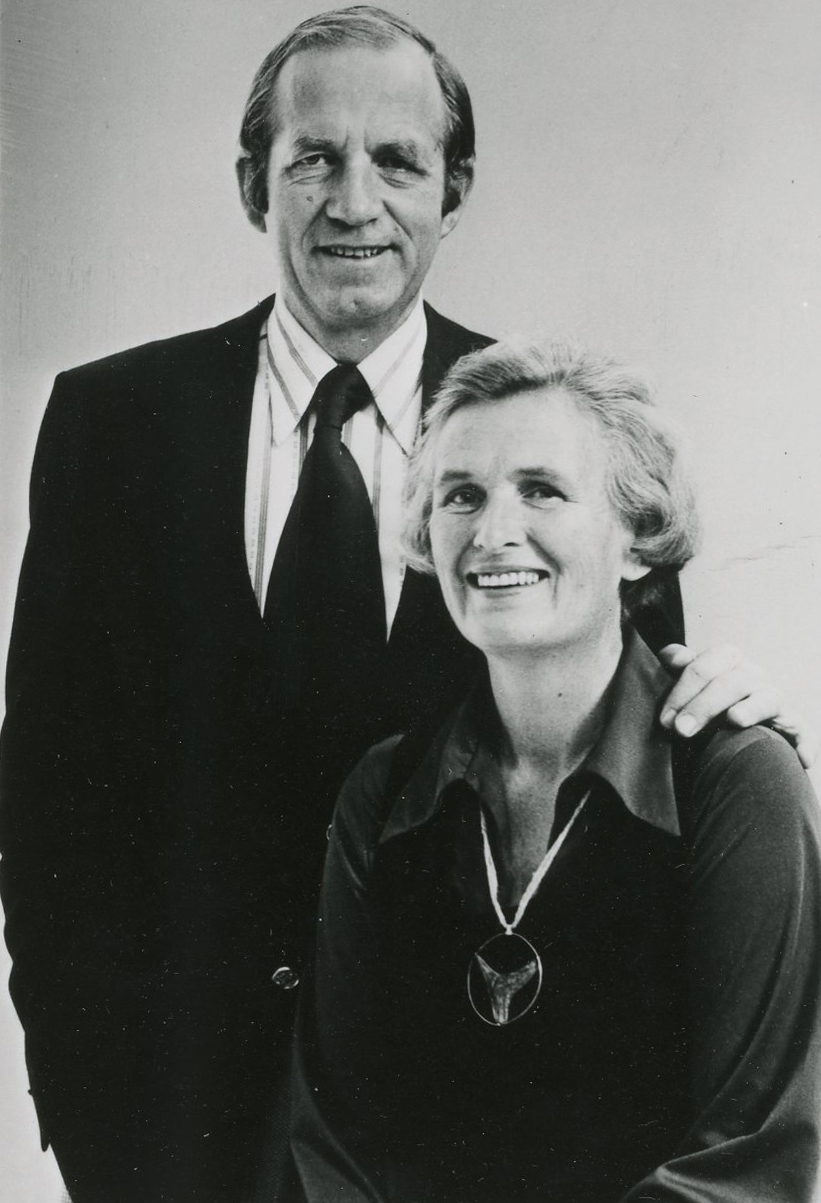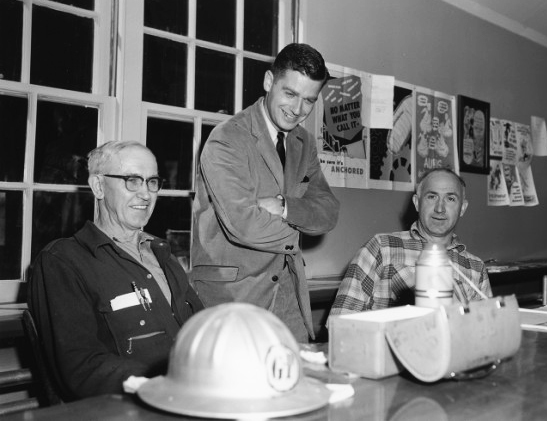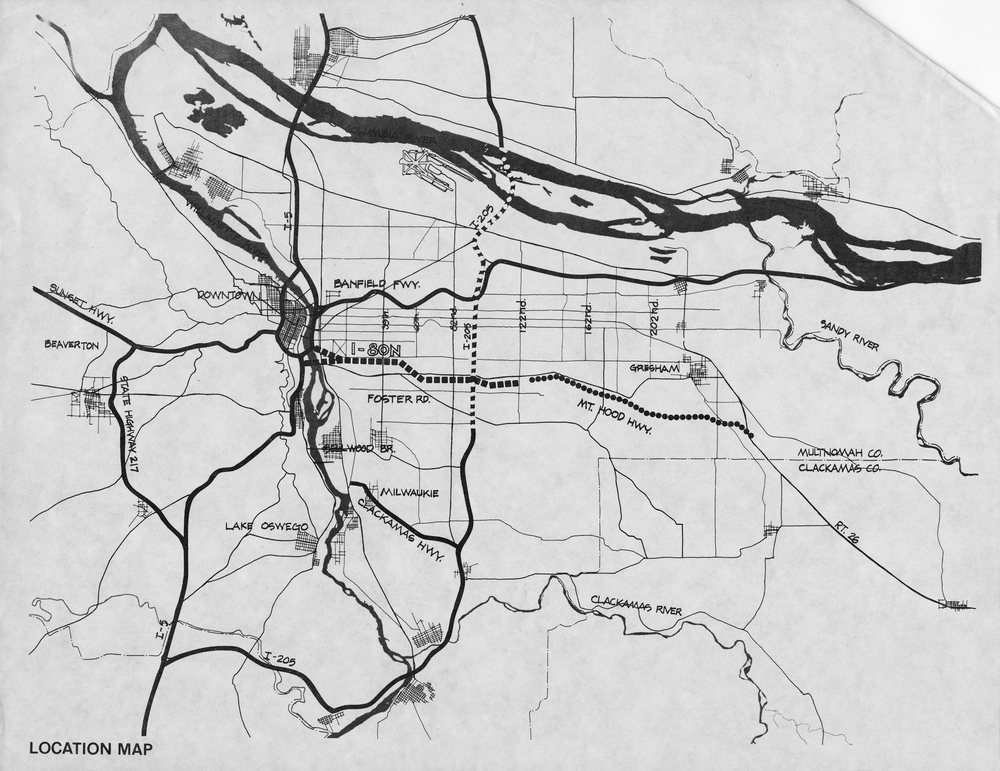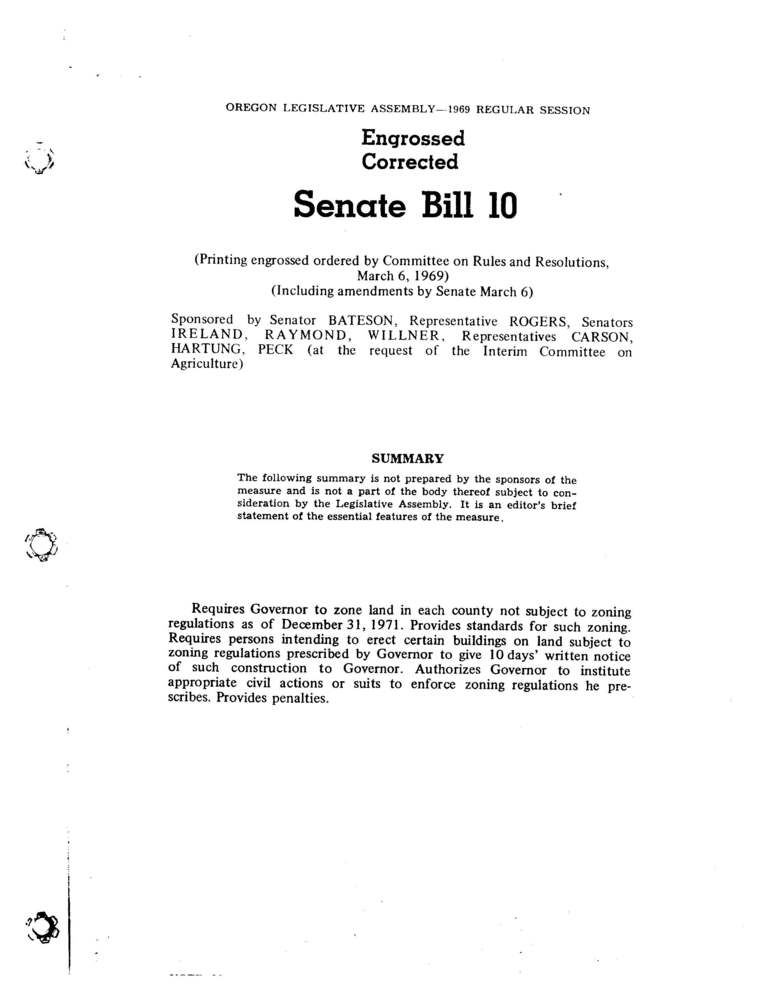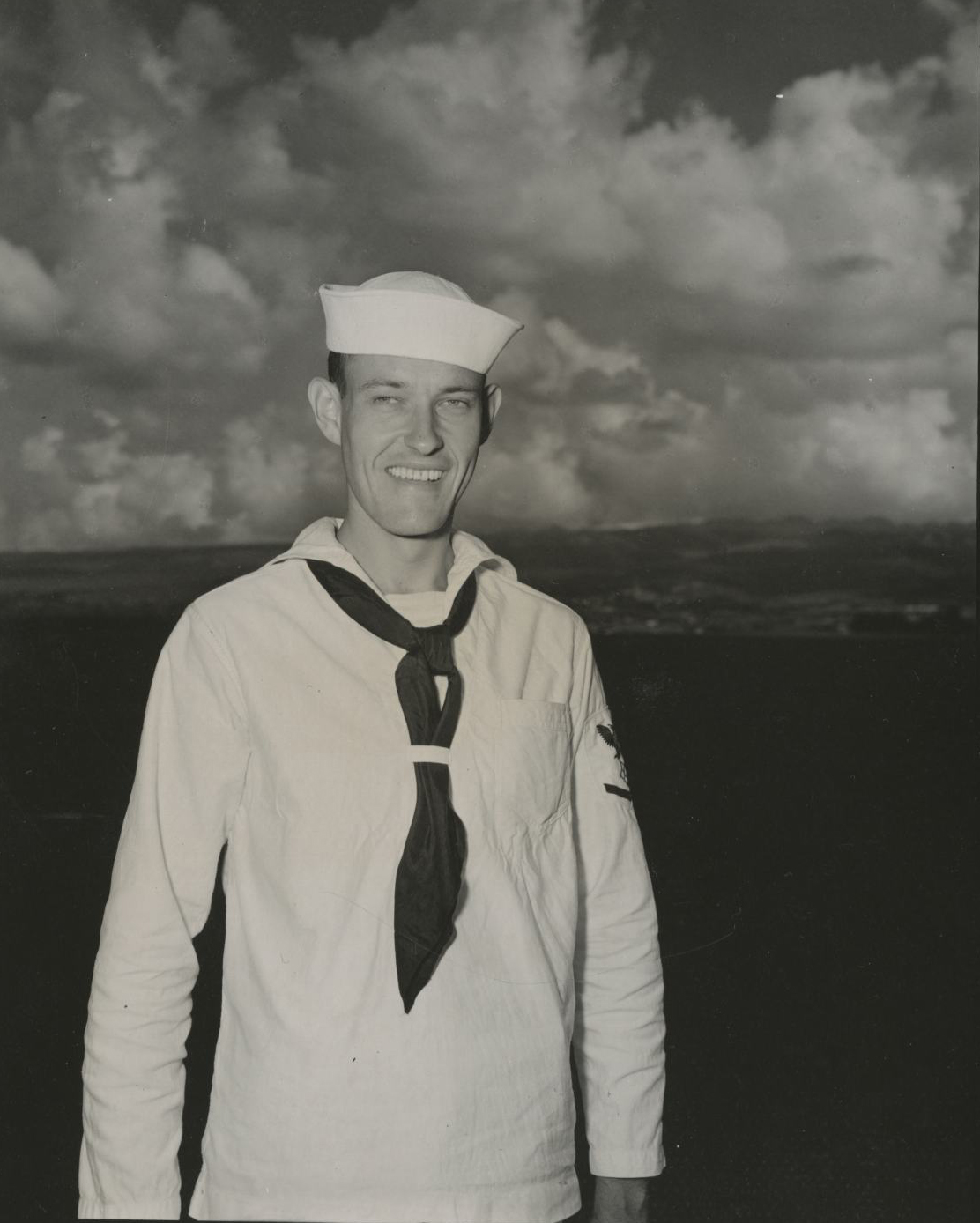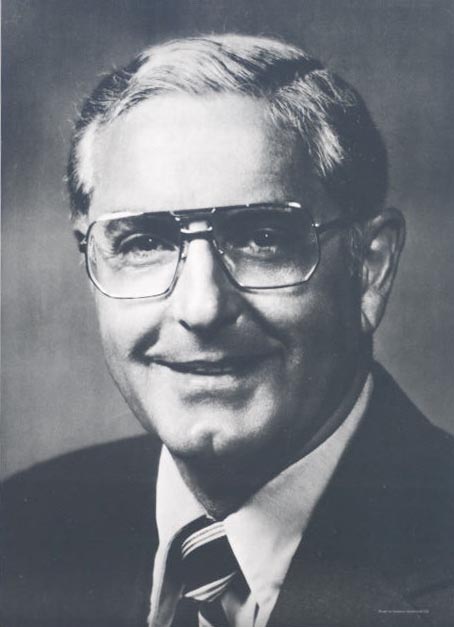Robert W. Straub, Oregon’s thirty-first governor, was a plainspoken politician, environmental leader, successful businessman, and innovative state treasurer. As a candidate for governor, he used his friendly rivalry with Tom McCall to help create new environmental protection policies and an Oregon ethic of environmentalism that continues today. As governor, Straub achieved success in environmental and social welfare policies. A complex man, he suffered from periodic depression and a stammer, but with a keen intellect and a strong will he overcame these challenges to leave a mark on Oregon politics.
Bob Straub was born in San Francisco in 1920 to an upper-middle class family and raised on a farm in Los Altos, California. Coming of age during the Great Depression, he was inspired by Franklin Roosevelt’s New Deal arguments for fairness to workers and became a lifelong Democrat.
Working his way through Dartmouth College (BA 1943, MBA 1947) as a logger, trash hauler, and manager of a rustic lodge in New Hampshire’s White Mountains—where he met his future wife, Pat Stroud—Bob Straub’s life path combined intellectual and physical rigor. The couple married in 1943, just before he was shipped off to Europe as part of the Quartermaster Corps. In 1947, they moved to Springfield, Oregon, where Straub worked as a manager in the Weyerhaeuser mill. He tired of office life, however, and began a business building houses, and was soon investing in the stock market and purchasing and managing forest and farm properties. He also became an active member of the Democratic Party.
Persuaded by U.S. Senate candidate Richard Neuberger to run for public office as part of a statewide strategy to get Democrats to the polls, Straub was elected to the Lane County Board of Commissioners in 1954. Ironically, given his later opposition to specific highways along the ocean and through Portland neighborhoods, Straub’s main accomplishment as commissioner was improving county roads, including blasting a straighter route through the Coast Range to Florence.
Before long, Straub’s restless eye turned to Salem, and he ran for a state senate seat from Lane County, winning easily in 1958. He soon found, however, that his progressive wing of the party was out of favor among the conservative Democratic leadership that held sway in the senate. Looking for a statewide platform, he won a term as state Democratic Party chair in 1960. Using this bully pulpit, Straub transformed himself into a statewide figure by bluntly and sometimes awkwardly attacking Governor Mark Hatfield and the Republicans for policy shortcomings, mostly in human services and environmental quality.
After a failed run for Congress in 1962, Straub benefited from Lyndon Johnson’s presidential landslide of 1964 and was elected state treasurer using the slogan “Get our money out of the mattress,” a reference to what he considered the poor investment practices of his predecessor Howard Belton.
As state treasurer from 1965 to 1973, Straub was a national leader. He hired outside investment managers who were judged and retained depending on their investment returns, a practice many other states copied. The foundation Straub established as treasurer resulted in investment returns for Oregon’s retirement and accident insurance funds that remain among the best in the nation. Hatfield, though not an initial fan of the brash Straub, later referred to him as the “Alexander Hamilton of Oregon.”
Democrat Straub served as a foil to Republican Tom McCall in losing battles for the governorship in 1966 and 1970, when he took strong environmental stands on issues that McCall agreed with, such as beach protection and pollution cleanup. McCall agreed instantly, for example, with Straub’s 1966 plan for a series of parks, trails, and water passages along the Willamette River, naming it the Willamette Greenway.
Straub’s constant pressure pushed McCall to be more outspoken on environmental protection issues than his party’s business supporters liked. That pressure included defeating a plan that McCall supported to build a highway on the Nestucca Sand Spit near Pacific City and attempting to pass a ballot measure in 1968 that called for a penny-a-gallon gas tax to secure public ownership of Oregon’s beaches.
By May 1970, the gubernatorial election and what the media termed the “Tom and Bob Show” dominated airtime. Straub was perceived as the more decisive candidate and led McCall in polls, but McCall’s endorsement of a state-sponsored rock concert at McIver Park in August and its success in attracting antiwar protestors away from an American Legion convention in Portland demonstrated the decisiveness and creativity for which McCall is now known. He easily defeated Straub in November.
Straub completed his term as treasurer in 1972 and ran again for governor in 1974, facing conservative State Senator Victor Atiyeh. McCall endorsed Straub, whose 58-42 percent landslide victory was one of the most lopsided in Oregon history. Paradoxically, during the triumphant campaign, Straub was diagnosed with bipolar disorder and depression; he received lithium treatment for the rest of his life.
Straub settled into the governor’s office with the goal of consolidating the environmental gains made during McCall’s second term, especially fleshing out the statewide land-use planning law. At great cost to his popularity in rural areas, he fought off two attempts to repeal the land-use laws at the ballot box. He responded to the energy crisis of the 1970s by creating the Oregon Department of Energy and negotiating federal hydropower rates for residential customers living in private utility service areas. Working with officials in Portland and Multnomah County, he convinced Congress to allow transferring federal highway funds for the proposed Mount Hood Freeway to public mass transit projects.
Straub promoted affirmative action initiatives that resulted in the appointment of more women and minorities to government positions than any previous governor. He also supported innovative programs for Oregon’s vulnerable populations, most notably Project Independence, which became a national model for helping elderly people remain in their homes.
In 1978, fighting a growing conservative tide in the state and the nation, Straub headed off an attempted 1.5 percent property tax limitation measure that would have reduced local tax collections. He called the legislature into special session and placed an alternative measure on the ballot, which he called the Oregon Plan. Both measures failed, and Straub suffered the consequences as Atiyeh handily defeated him in November. As the state and the nation turned to the right in 1978, the curtain was drawn on the “Tom and Bob Show.” Atiyeh defeated them both: McCall in his comeback bid in the primary and Straub in the general election.
In January 1979, Straub returned to his business enterprises, which included farms in Springfield, Salem, Curtin, and Willamina and a ranch in Wheeler County, and he and Pat remained active in civic affairs in Salem. Bob Straub State Park was established in 1988 in Pacific City to honor his protection of the Nestucca Sand Spit. Straub died in 2002 after a battle with Alzheimer’s, which he talked about publicly as an advocate for destigmatizing the disease.
-
![]()
Bob Straub campaign material.
Courtesy Oregon Hist. Soc. Research Lib., Mss1513
-
![]()
State Treasurer Straub at protest rally against Nestucca Spit Hwy, 1967.
Courtesy Oregon Hist. Soc. Research Lib., 014789
-
![]()
Secretary of State McCall, State Treasurer Straub, Gov. Hatfield, 1966.
Courtesy Oregon Hist. Soc. Research Lib., 012489
-
![]()
Straub speaking for the beach gas tax bill, 1968.
Courtesy Oregon Hist. Soc. Research Lib., 00473
-
![]()
Bob Straub campaign material.
Courtesy Oregon Hist. Soc. Research Lib., Mss1513
-
![]()
Bob Straub campaign material.
Courtesy Oregon Hist. Soc. Research Lib., Mss1513
-
![]()
Robert and Pat Straub, 1975.
Courtesy Oregon Hist. Soc. Research Lib., 019640
Related Entries
-
![Mark O. Hatfield (1922-2011)]()
Mark O. Hatfield (1922-2011)
As an Oregon legislator, secretary of state, governor, and United State…
-
Mount Hood Freeway
The Mount Hood Freeway, if constructed, would have passed through south…
-
![Richard Neuberger (1912-1960)]()
Richard Neuberger (1912-1960)
When he was elected to the United States Senate in 1954, Richard Neuber…
-
![Senate Bill 100]()
Senate Bill 100
Signed into law on May 29, 1973, Oregon Senate Bill 100 created an inst…
-
![Thomas William Lawson McCall (1913-1983)]()
Thomas William Lawson McCall (1913-1983)
Tom McCall, more than any leader of his era, shaped the identity of mod…
-
![Victor Atiyeh (1923-2014 )]()
Victor Atiyeh (1923-2014 )
Victor George Atiyeh was governor of Oregon from 1979 to 1987. The firs…
-
![Vortex I music festival]()
Vortex I music festival
During the war-hot summer of 1970, thousands of young people began stre…
Related Historical Records
Map This on the Oregon History WayFinder
The Oregon History Wayfinder is an interactive map that identifies significant places, people, and events in Oregon history.
Further Reading
Clucas, Richard A. "The Political Legacy of Robert A. Straub." Oregon Historical Quarterly 104:4 (Winter 2003): 462-77.
Johnson, Charles K. Standing at the Water's Edge: Bob Straub's Battle for the Soul of Oregon. Corvallis: Oregon State University Press, 2012.
Oral History Interview with Robert Straub. SR 1128. Oregon Historical Society Research Library, Digital Collections, 1991.
Robert W. Straub Oregon Beaches Collection. Western Oregon University, Hamersly Library, Monmouth, Oregon. http://digitalcommons.wou.edu/straub/.
Walth, Brent. Fire At Eden's Gate: Tom McCall and the Oregon Story. Portland: Oregon Historical Society Press, 1994.

